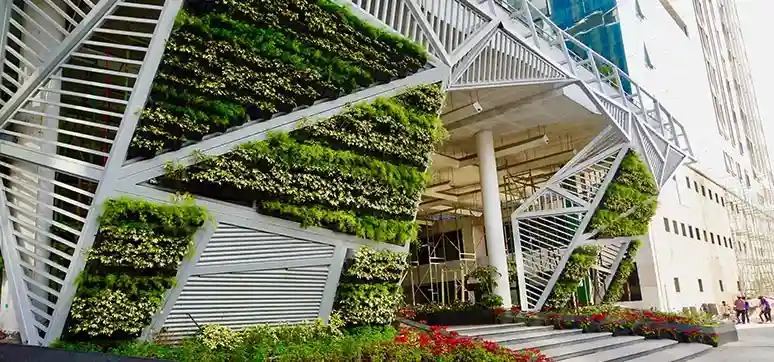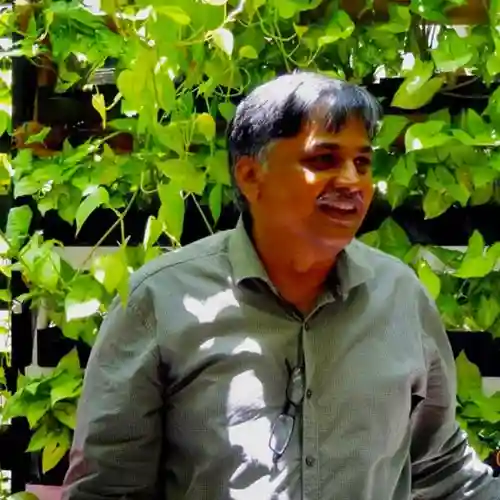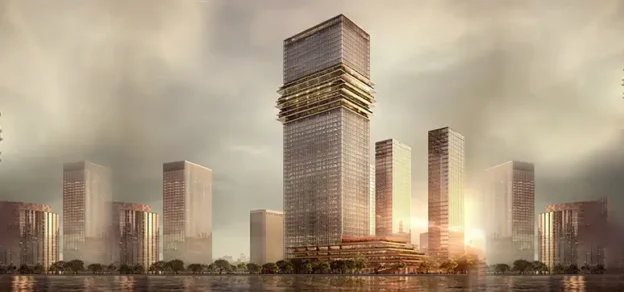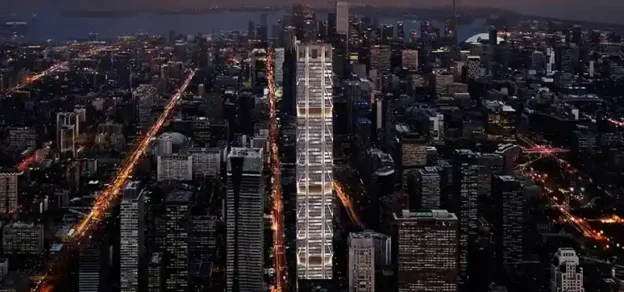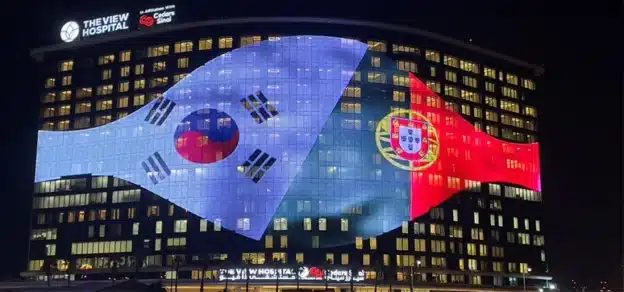In recent years, Vertical Garden has become a favourite among those who wish for lush green surroundings but are faced with space restrictions. Vertical garden is not limited to barren outdoor walls or indoor spaces but has come to include façades as well. A well-designed and constructed vegetated façade can provide a thick layer of greenery that is aesthetically pleasing, can act as a thermal insulator and provide a habitat for fauna.
Vertical gardens have various names in the industry, namely living walls, bio walls, green walls, vegetated walls, breathing walls and so on, depending on their individual brands.
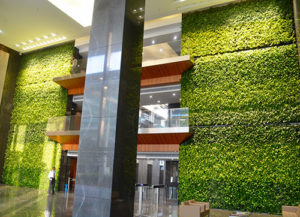
Creating greenery over a façade or green facade is a task that requires certain elements of engineering, architecture, horticulture and irrigation. Selecting the right vertical garden system is a crucial step in the installation of a green façade, and is undertaken by a team of experts after considering a number of factors like load-bearing capacity, climatic conditions, etc. Engineers design the structure taking into account the dead load of the vertical gardening system and the wind load on it with reference to local climatic data.
Architects design the space for the vegetation, select plants that satisfy horticultural limitations and design access routes for maintenance purposes. Horticulture specialists suggest plant palettes after considering the climate, microclimate, direction of vegetation and seasonal variations.
A planting plan for a vertical garden is developed after taking into account plant sustainability, growth pattern, exposure to environmental forces, maintenance requirements as well and a plant’s ornamental value. Working with plants requires perfecting the system of hydrology, which mainly includes irrigation and drainage. Vertical vegetation demands a carefully designed, automated watering system that is either time-based or interactive wherein different sensors, valves and pumps communicate with each other and perform necessary actions.
Controlling water pressure is also a key component within vertical garden irrigation systems. The optimal performance of vegetated façades depends greatly on sincere as well as scientific maintenance service. The maintenance team has to work proactively as the impression of the building decor depends largely on the status of vegetation over the façade.

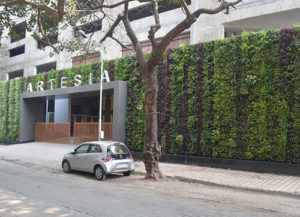
The main difference between vertical garden systems and growing vertical greenery is that the plants are rooted and grown over the vertical surface itself and not in planters at the bottom of the surface or as climbers on mechanical structures. In order to grow these plants, a variety of systems can be implemented namely, panel, box, pot, tray, fabric, trellis and suspended (hanging green wall) system. Each of these has a unique set of requirements and produces unique results. Some of these give good vegetation cover on one side while some provide greenery on both sides. They are either mounted on a vertical surface or on some kind of structure or are hanging and are installed on wire ropes.
Some of them are modular systems, while others are not and a few can be uninstalled and reinstalled multiple times. The materials used also vary, but mainly include plastic, metal and fabric. A few of these systems perform seasonally as the planting cavities are not designed for permanent use.

There are a few challenges to consider in the execution and maintenance of vertical gardens. These gardens are challenged by gravity and thus, the majority of the time the planting is required to be lightweight and shallow. Additionally, seasonal variations along with the height and scale of the garden greatly influence the intensity and duration of light each plant receives.
A simple way to counteract these challenges is to introduce modern technologies like artificial lights, mechanical anchors, water reservoirs, thermal insulating media, etc.
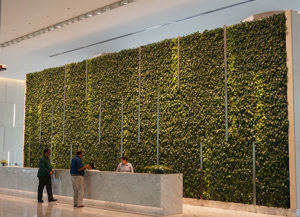
Sustainability in terms of design, materials and construction is also an important factor to consider when discussing vegetated façades in India. A well-designed and carefully built vertical garden system has a number of requisites. Firstly, the module should be strong and long-lasting with an elaborate irrigation system embedded within the module as well as the system. An automated irrigation system, one that relies on time and sensors, is necessary as it reduces water wastage and maintenance costs and risks. Secondly, the growth medium should support the growth of white roots at the beginning and in the long run.
The longevity of the growth medium is also important to avoid replenishments. For this purpose, young biomass is avoided and the use of clay or soil as it can threaten the drainage system in the long run.
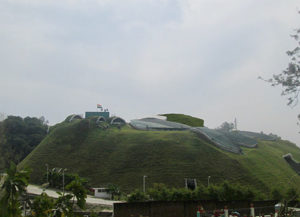
Additionally, the growth medium recipe should sustain and protect the plant root zone from high temperatures. Thirdly, the system should be designed to withstand high wind pressures, positive and negative wind loads, vibrations and shocks and changing climatic conditions. The ratio of green area coverage to surface exposure to environmental forces should be optimum. Lastly, the success of vertical greenery depends upon the right plants, hence expertise in the matter is a must.
Plants should be selected after considering plant sustenance and performance with respect to climatic zone, light intensity, humidity, temperature, air-conditioned environments, wind velocity, salt spray, pollution and other factors. The growth and anchorage of roots are extremely important for the vertical garden to be a success and hence should be monitored carefully after plant selection.

The Green Façade

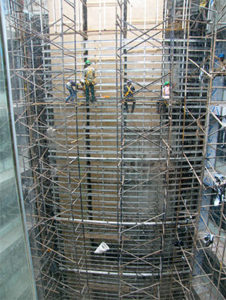
The HDFC green façade is a unique design where a green wall has been introduced in the courtyard of a seven-storey building at BackBay Reclamation, Mumbai. The green wall rests on a curved fabricated structure that measures 9.1 m wide x 21m high. The fabrication structure, made of hot-dipped galvanised MS, is a stand-alone type of design and is anchored in RCC members. The dead-load of the vertical garden along with vegetation and fully saturated water is approximately 91.50 kg/sq m.
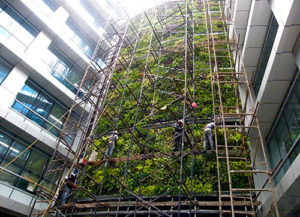
The living wall plant modules utilised in this green façade were grown in the ELT facility at Pune from July 2013. The horizontal members and drains were produced and installed on the fabricated structure in a span of twelve days. Pre-grown modules were transported to the site once the site was clear of dust, paint, fumes, smoke and other hazardous conditions that could potentially damage the modules. The installation was completed within seven days on-site.
Some of the challenges we faced and successfully resolved were as follows:
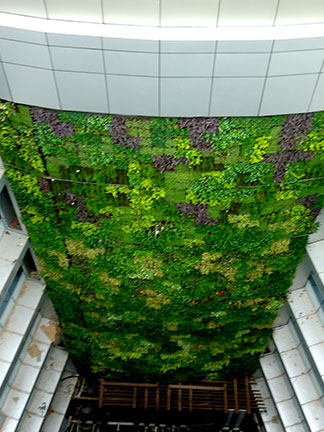
- Maximum work was carried out off-site and systematic planning and support from the PMC team made it achievable.
- All materials were lifted by head-loads due to the site being an enclosed courtyard and arrangements for a lift, hydraulic platform or a cherry-picker were not possible. A pulley and rope system, with a specially designed anchor, was introduced to lift the planted modules to the required height while ensuring no damage was done to the plants.
- The selection and performance of an irrigation system for the green wall was crucial since access for maintenance was restricted to merely two to four times a month and any failure of the irrigation system could damage plants enormously.
- The light intensity varied from 350 lux to 45,000 lux and taking into consideration seasonal variations, selecting the right plants was a challenge. The three zones of light intensity were no direct sunlight throughout the year (45 per cent); sunlight during a few months of the year (35 per cent) and sunlight throughout the year (20 per cent).
- Once the landscape designer decided on the general idea and concept for planting, a free hand was given to choose the arrangement of the plants. Then, the plant mix for each area was decided and the plants were transported in batches.
- The green wall, located in the courtyard, could be viewed from multiple sides of the building. The HDFC senior management occupied offices in the same building. Hence, the all-round performance of the green wall was very important. Thus, preventive measures were taken and the on-site nursery was equipped with an extra stock of 150 modules of the living wall. Additionally, the right amount of feeding and timely pruning was the strategy employed.
- A cradle to access a green wall was introduced that could also be utilised for cleaning the glass and other members of the façade.
The strategy, planning and execution have ensured the success of the green façade for almost four years and made it the talk of the town!
QUICK FACTS
Project: HDFC Ltd.
Location: Mumbai
Client: HDFC Ltd.
Architect: Hafeez Contractor
Landscape Consultant: Ms. Kavita Shrivastav
Green Wall Consultant: Ecogreen Landscape Technologies India Pvt. Ltd.
Materials used for Vegetated Façade: ELT Living Wall System
Commencement Date: July 2013
Completion Date: September 2013
